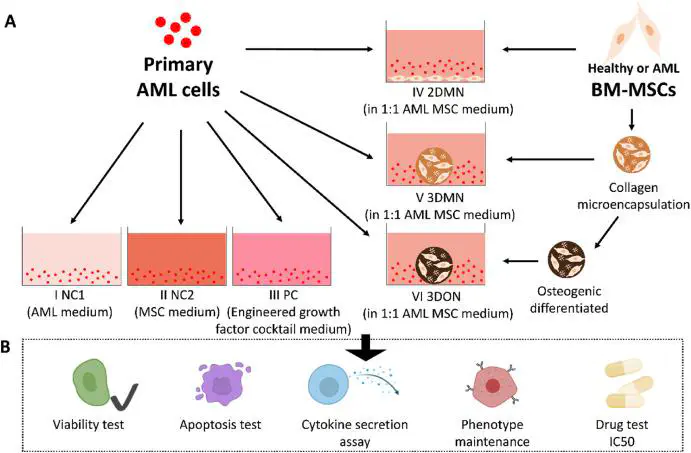New Paper: Microenvironment matters: In vitro 3D bone marrow niches differentially modulate survival, phenotype and drug responses of acute myeloid leukemia (AML) cells

In this paper, we reconstitute a 3D osteogenic niche (3DON) mimicking that in bone marrow to support primary AML cell survival and phenotype maintenance in cultures. This is part of our complex organoid models technology.
Check out the published paper here: https://doi.org/10.1016/j.biomaterials.2024.122719
Abstract
Acute myeloid leukemia (AML) is a deadly form of leukemia with ineffective traditional treatment and frequent chemoresistance-associated relapse. Personalized drug screening holds promise in identifying optimal regimen, nevertheless, primary AML cells undergo spontaneous apoptosis during cultures, invalidating the drug screening results. Here, we reconstitute a 3D osteogenic niche (3DON) mimicking that in bone marrow to support primary AML cell survival and phenotype maintenance in cultures. Specifically, 3DON derived from osteogenically differentiated mesenchymal stem cells (MSC) from healthy and AML donors are co-cultured with primary AML cells. The AML cells under the AML_3DON niche showed enhanced viability, reduced apoptosis and maintained CD33+ CD34-phenotype, associating with elevated secretion of anti-apoptotic cytokines in the AML_3DON niche. Moreover, AML cells under the AML_3DON niche exhibited low sensitivity to two FDA-approved chemotherapeutic drugs, further suggesting the physiological resemblance of the AML_3DON niche. Most interestingly, AML cells co-cultured with the healthy_3DON niche are highly sensitive to the same sample drugs. This study demonstrates the differential responses of AML cells towards leukemic and healthy bone marrow niches, suggesting the impact of native cancer cell niche in drug screening, and the potential of re-engineering healthy bone marrow niche in AML patients as chemotherapeutic adjuvants overcoming chemoresistance, respectively.